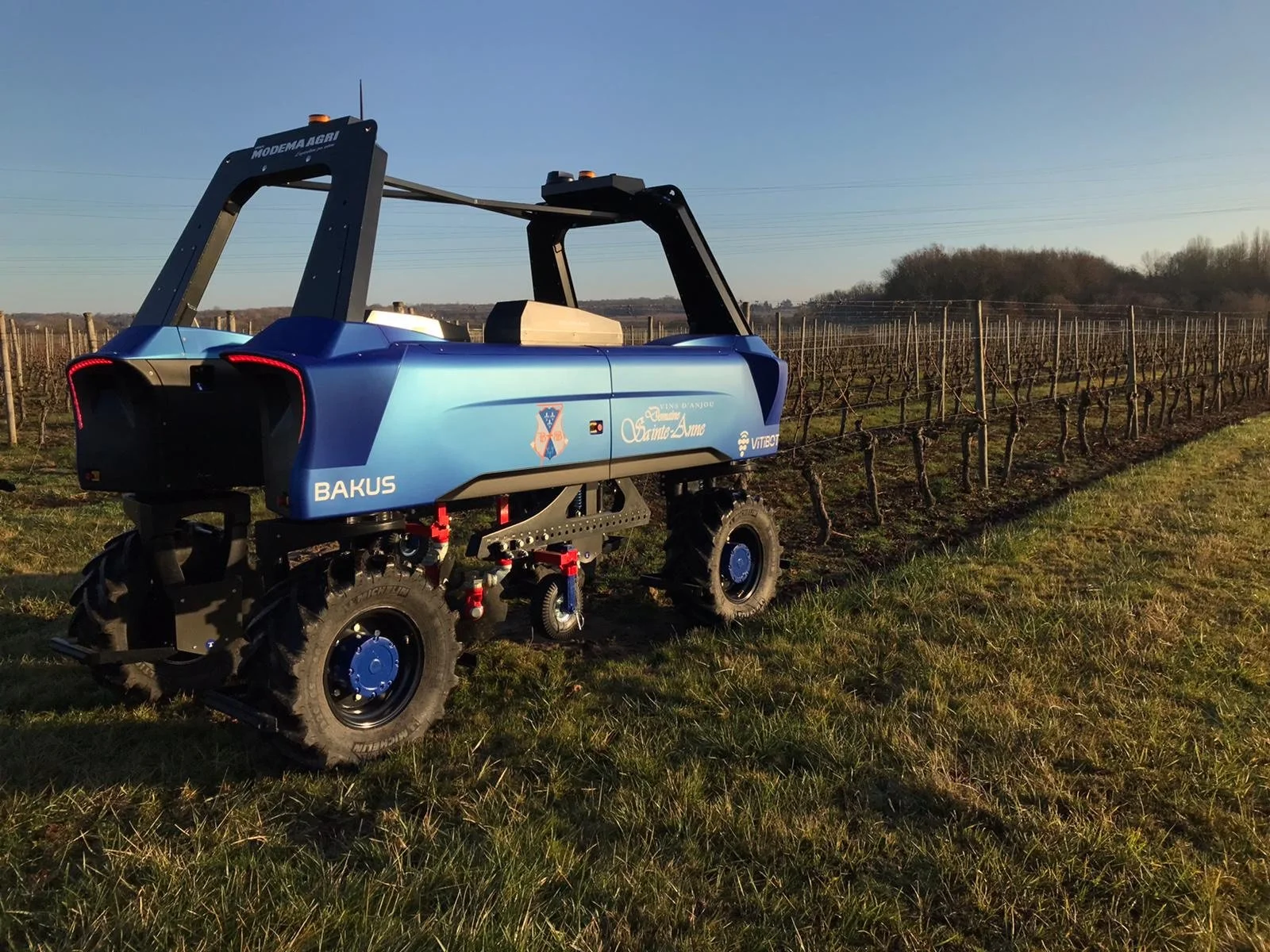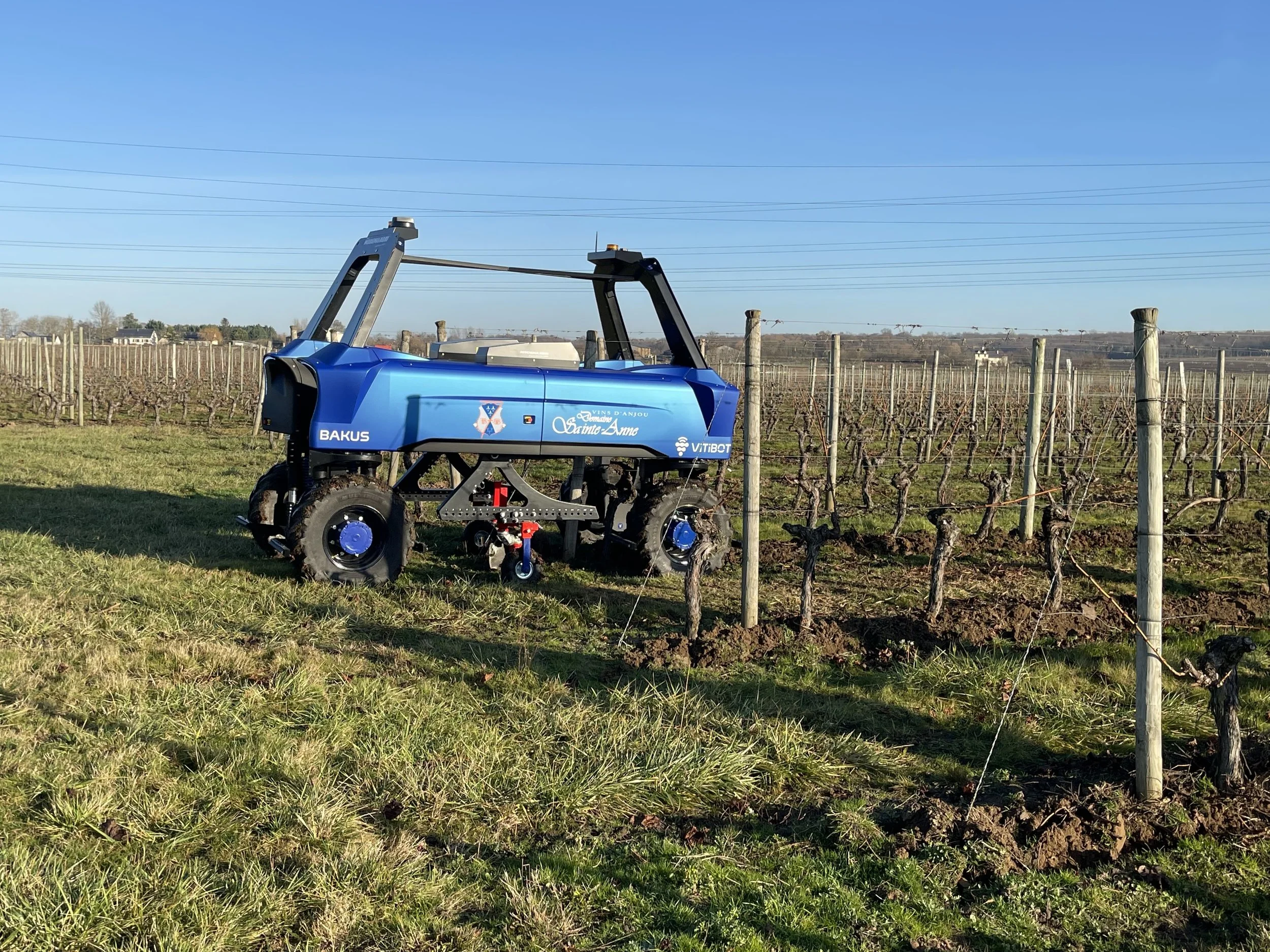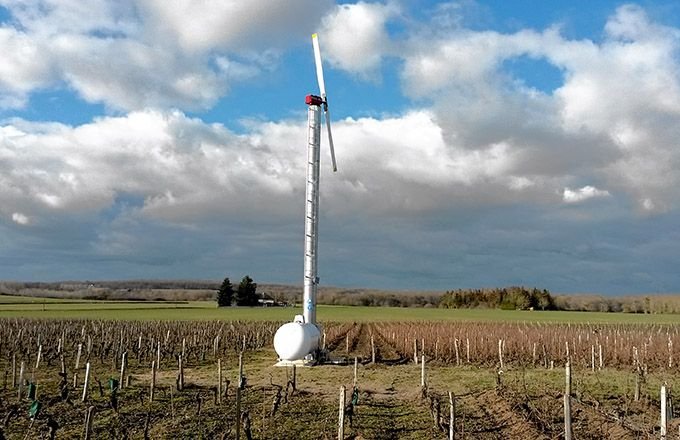ROBOT BaKus IN THE VINEYARD: Replace glyphosate with robotic soil cultivation
“We have invested in the future”
Are you a French winegrower ? Are you interested in technology ? In June 2022, AgTech Market will meet with winegrowers from the main French regions to discuss working methods, challenges and innovations.
More information about the project here: EXPLORATION OF THE FRENCH VINEYARD
Introduction
Today we meet Florian Brault, 30 years old and with over 10 years of experience in the family vineyard. In January 2022, Florian unofficially took over the management of the vineyard and the winemaking. Together with his brother Boris, who is responsible for the marketing of the estate's products, they are part of the 7th generation of winemakers in the family. Their property, Domaine Saint Anne, is located in Brissac-Quincé, Anjou, France. Convinced that herbicides are not a sustainable solution, they decided in December 2021 to invest in a robot to mechanically weed their 55 hectare vineyard. Let's meet him to understand his choice, why he invested in a robot, his feedback and his vision for the future
Why have you invested in robotics? Did you receive any grants?
Initially, the 55 hectares of the domain were weeded chemically. With all the studies conducted on the impact of herbicides, the use of chemicals has become more restrictive, and they may be banned in the coming years. For our part, we have been wanting to change the estate and eliminate herbicides from our working methods for several years. It had become essential to find an alternative to chemical weed killers.
After researching the possibilities for replacing chemical products, we identified two options. The classic tractor option, which cost about 140,000 € for a Vario tractor and its tools, plus we had to find a competent tractor operator to take care of the soil work. Or the option of a weeding robot, with its integrated tools, which certainly cost more, for 180 000€, but without the need to find an additional tractor operator on the estate.
For the moment, we have not yet received any grants, even though we have submitted a project to the PCAE (Plan for Competitiveness and Adaptation of Agricultural Holdings). If the project is validated, we could recover a maximum of 57,000€, which means the robot would cost a little more than 140,000€.
Given the small difference in the final price between the two solutions and the difficulty of recruiting qualified tractor operators in the sector, we decided to bet on the future!
How did you know which robot technology was best for your vineyard?
The project started to mature in my head in early 2021. I first learned about the machines that existed on the market, by watching a lot of videos. Then I signed up to participate in public demonstrations that were taking place in my area. These half-day events allow me to meet the manufacturers who present their machines in real conditions at the vineyards, in partnership with the distributors.
I participated in two of them with two different manufacturers. When you are thinking of investing in these technologies, I think it is important to come and see them running in real conditions. It is more meaningful than a video, and it also allows you to meet the manufacturers and their distributors, to understand their product vision and of course to see the machine's capacity in real life.
After these public demonstrations, I was rather convinced in my choice, but I absolutely wanted to test the machine on my plots before making the final purchase. So we organized a one-day demonstration on the estate. The idea was to see if the robot could work in the specific conditions of my estate, with aging plots that had never been worked. We also took the opportunity to test other tools such as intercepts, crumbling and trailing discs, kress fingers and the decavator, to see what worked well with the type of soil on the estate.
How did you learn to use the robot? How long did it take you to feel autonomous?
In addition to the demonstrations that I did, when I received the robot there was a day of training done on site with an expert from the manufacturer. This day allows us to understand the machine and its reactions, how to manage the possible human presence and the other machines. We also review the assembly/disassembly of the tools and their respective settings. And we finish the training by going to one of my plots to start the machine in autonomous mode.
To start the machine, I was quickly autonomous, at the end of the training day it was good. For the soil cultivation it was more complicated because we had no experience in this field. Fortunately, we had made an agreement with the dealer to train us the first year on tillage. He came back several times to show us how and when to use the tools. But after a good day on each tool, good advice and some visual cues on the elements, now it runs itself!
How was the start-up of the machine, the good and the bad?
During the first week of the robot's launch and with good follow-up from the dealer and the manufacturer, we managed to weed 12 hectares. This is very encouraging for a beginning, especially since no tillage had previously taken place in these plots.
We encountered two main problems in the first few weeks: a faulty electronic card and the mapping was shifted. If the first element was quickly replaced by a new component, it took a little more time for the mapping.
On the 55 hectares of the domain, we had voluntarily asked the manufacturer to map 33.4 hectares. Because it is important to know that some of our parcels were planted by my father and his father more than 40 years ago. This implies that some plots are not straight and the same goes for some vines. It took us a few passes with the robot before we could adjust all the gaps between the mapping and the rows with the manufacturer, which cost us a few vines.
How did you adapt your vineyard and your growing methods to integrate the robot?
Part of the vineyard is made up of aged, not straight and fragile vines. We know that if we put the robot in these conditions, it may tear up a good part of the vineyard. If you want your robot to run autonomously without intervention, you have to put it in the right conditions. At the moment, it is still up to us and our plots to adapt to the robot.
In the 33.4 hectares of plots, I have for example changed all the stakes of the plots which were too fragile to protect the young vines from the tools of the robot.
Afterwards, between chemical weeding and mechanical weeding, I had to relearn everything and fortunately our dealer was there. A vine that has never been worked has a surface and fragile root system. The first passages of the robot will weaken the plants before they adapt and develop a stronger root system. We also know that during this first year of transition, we risk losing about 10% of our production, but we have to go through it !
The vineyard will slowly evolve with the robot. We are going to pull up about 12 hectares of old plots in the next few years to replant in conditions that are more suitable for the robot.
How do you use the robot? How many hours? Have you noticed any evolution on the machine since the beginning?
We are lucky on the domain, we have plots of 5 to 10 hectares which lend themselves well to the use of this machine. Then we have a 3 meter spacing, which facilitates the passage of the robot and allows us to have a good productivity. We work at 5 - 6km/h with intercepts, crumbling and trailing discs, Kress fingers and decavator tool, we manage to cover 1 hectare in 1h15 - 1h30, which makes it easy to make several passes per plot.
I still do not have total confidence in the cartography to devote myself to another activity while monitoring it, so for the moment I stay a few meters behind the machine, but it happens that for half a day, I do not touch anything.
In 4 months of use, we have already used the machine between 80 and 100 hours, and weeded 80 hectares, 2/3 passages depending on the plots. It is still a bit early to have noticed a big evolution. I know that the half-turns have gone from 40 seconds to 15 seconds, and that other updates have taken place to correct errors and add features.
How do you imagine your robot evolving and improving in the next years? Are you thinking of automating other tasks?
For the moment he is working on 33.4 hectares, but it is planned that he will take care of the 55 hectares of the domain. It will also continue to progress in reliability, productivity and autonomy. For autonomy, I hope that the machine will be able to detect humans better and interact better with its environment, this is a key step to make it even more autonomous without me being there.
Legally, it would be nice if the law could progress and allow us to move further and further away from the robot, that would allow me to do other tasks elsewhere.
And finally, of course, I would like to be able to use the robot for other activities than tillage to make it profitable even faster. I am thinking in particular of new functionalities such as mowing, pre-pruning or even trimming. If we are adapting our vineyard to the arrival of this robot, it is because we are already preparing for the next step, it is a bet on the future.
What advice would you give to other farmers who are considering buying a robot?
I would advise you to be well informed about the different machines available on the market, to go and see them and test them on your farm, to see and know which one is the most adapted to your needs.
Then I would say that you should not be afraid to adapt and evolve your farm so that the robot can work, it seems to be a big obstacle at the beginning, but once it is set up, it makes life easier!
And to finish on the financial part, each project and each banker are different. But in general, as soon as a project is well studied, well prepared and profitable on the medium/long term, the banker follows us!
And for those who wish, they can come to the domain to see how we have integrated the robot into the farm.
ARE THERE ANY OTHER TECHNOLOGIES THAT YOU ARE PARTICULARLY LOOKING FORWARD TO?
Before investing in this robot, I asked about steam weeding and electric weeding, but the feedback I got did not convince me.
At the moment, I am looking into confined treatment. After having drastically limited our consumption of glyphosate in the vineyard, I would like to succeed in reducing the consumption of other phytosanitary products as well.
With the frost of the last few weeks, I am also looking into antifreeze towers. We already have one that my father had built in 1997. It is still a big investment, but it only takes one year of frost for it to pay off.
Antifreeze towers, Photo from mon-viti.com
WANT TO LEARN MORE ABOUT TECHNOLOGIES AND THEIR EVOLUTION, THESE MAY HELP YOU !
Want to better understand new agricultural technologies ?
What do other farmers think about new technologies and investment ?
The Family Farm | Conventionnal Field Crops Farms in France
Robot in the vineyard : Saving time by automating soil cultivation | French wine grower experience with a robot








